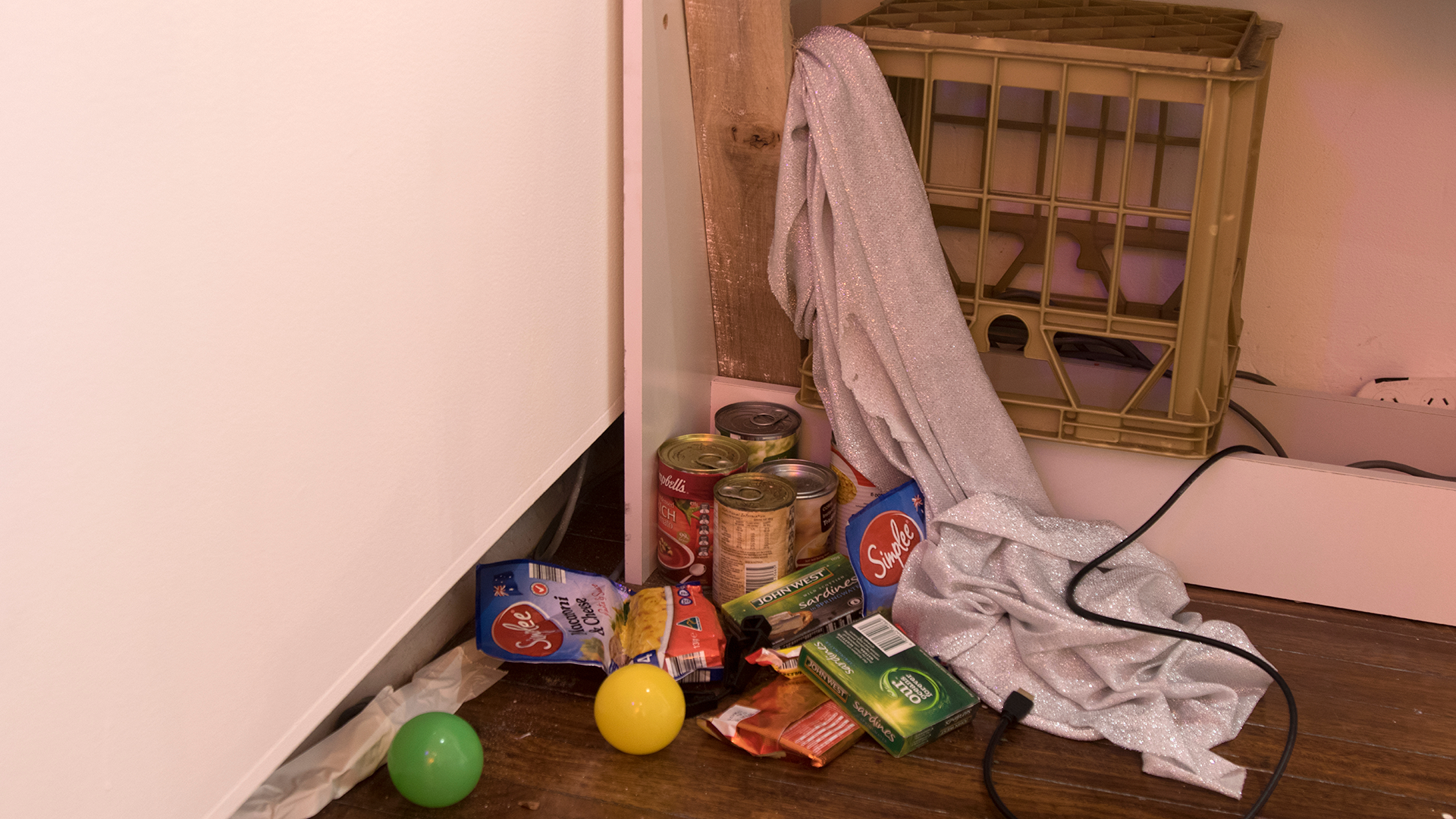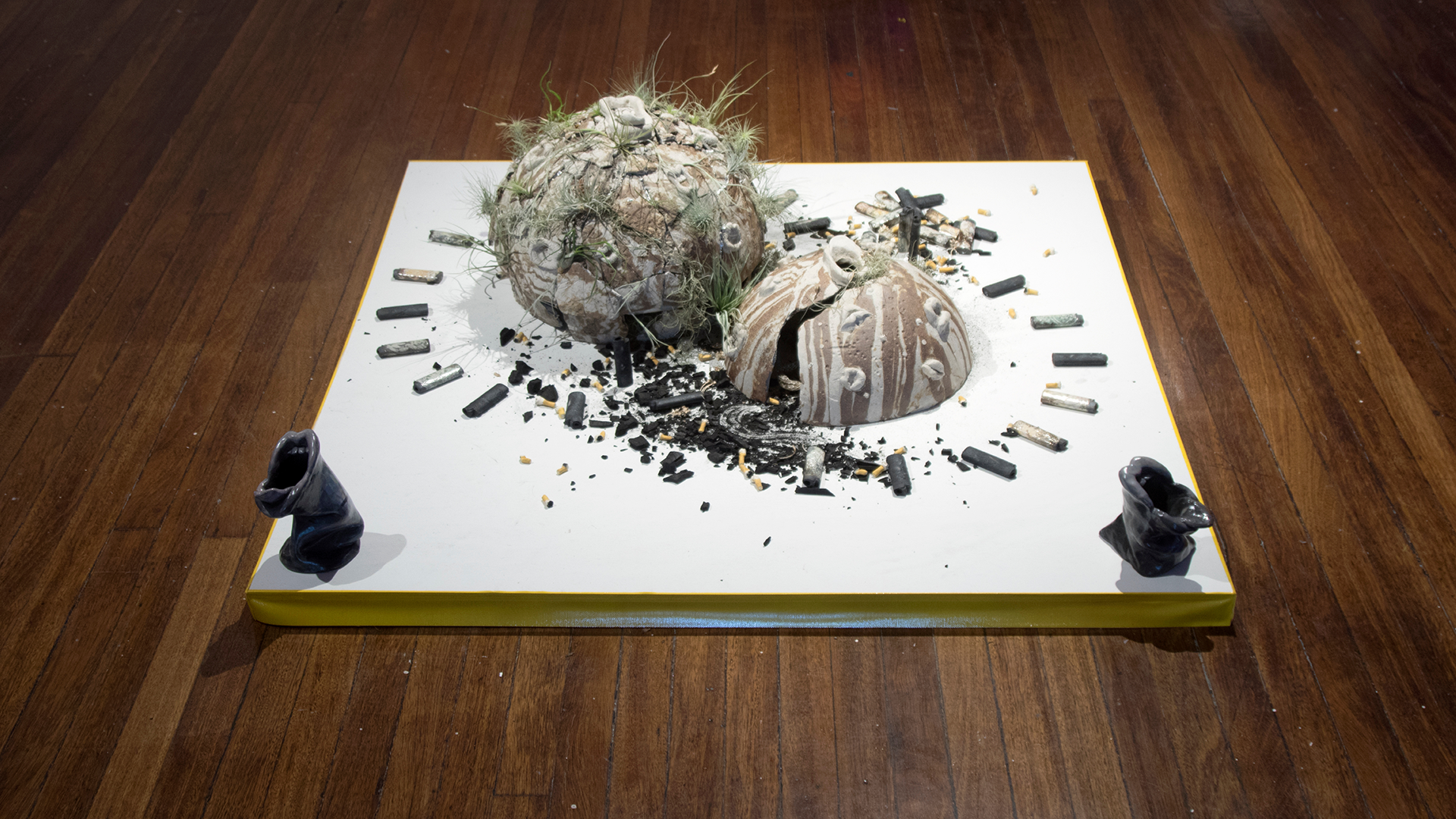Archiving Apocalypse
Joel Hedge, Blake Wilson, Tahlia Carr, Bruno PanucciCurated by Melissa Mills
Space Trwo
13 June - 30 June 2018
Opening night Tuesday 12 June 2018, 5-8 PM
Rather than an event insurmountable, universal and definitive, Archiving Apocalypse considers the idea of ‘apocalypse’ as a lived experience, which is often personal, political and cultural. Engaged with the idea of living through and with apocalypse, the artists in this exhibition turn to experimental methods of representation to produce meaning, community and critical discourse surrounding what is recorded (and how), and what is left behind.
Working with installation, video work, VR, ceramic, and material collage, each artist takes up an individual idea of ‘apocalypse’ in the form of colonisation, the history of HIV, experiences of mental illness and gender dysphoria, and ecological disaster. Reaching back through the past, into the present, and imagining the future for these temporal spaces of crisis also allows us to work with and through our global anxieties and histories.
Ideas of tangibility, temporality and duration also coalesce through the course of the show – works will be altered, destroyed or become different between the shows opening night and its final day. This brings to the fore a number of questions surrounding the role of the archive, and its susceptibility to destruction, misrepresentation and political control.
Special thanks to: Patrick Younis, Niko Plaskas, Celeste Carnegie, Matthew Shields, Joel Hedge, Fei Gao, Beau Mourer, Jarri Heydar, Phươngg Uyên, Dileepa Dayananda, Caitlin Welluno, Sophia Perilous Compton, Alana Anne Cotton, Cara David, Sïan Kelly, Luca Rex Holden, Mai Kanhukamwe, Brendan Donnellan, Mahn Lion, Tomasz Sierakowski, Miranda Longhurst.
Cover image: Courtesy of the artists
Images courtesy of the artists and Kudos Gallery. Photos: Nicholas Aloisio-Shearer
Archiving Apocalypse Q&A: An Interview with the Curator and Two Artists
Melissa Mills (curator)
Joel Hedge (artist)
Bruno Panucci (artist)
What is your idea for the show?
Melissa: Archiving Apocalypse is looking at histories and re-identifying and re-articulating what an apocalypse is for specific communities. It’s challenging the notion of apocalypse as a large gesture of destruction and irreparable damage, and instead looking at how communities can reach through that history and narrative, and come out the other side. Popular thought tends to see the idea of ‘apocalypse’ as a universal and absolute trauma, but we are looking at it as something that has been happening, and continues to happen, on a smaller scale.
There’s a thematic undercurrent of time and temporality running throughout the show; most artists are examining the past, but there’s also Tahlia, who is dealing with impending ecological apocalypse and the destruction of the earth. Each artist’s work is personal to the maker, ranging from addressing literal crisis to delineating personal narratives.
The show also looks at experimental processes of archiving, through performance, the body and presence. Its examines the idea that archives are not absolute, and are susceptible to destruction and desecration. It also questions how the archive functions, and how we can critically engage with the knowledge it contains.
What has the idea for the exhibition developed from?
Joel: We were inspired to break the idea of the apocalypse up into different locuses after coming across a quote - “what a privilege it is to say ‘the world is ending’ amidst recent political news when the world has ended for many people both in and outside of this country decades ago, while you’ve remained fed”. This made us start to think about the idea of apocalypse as something that doesn’t permeate everything simultaneously.
Melissa: The exhibition separates the idea of apocalypse into different narratives, and each artists’ work represents a subjective experience of the apocalypse to a specific community. Some of these communities we are focusing on include queer, trans, post nation and ecofeminist.
Joel: We also wanted to break the idea of apocalypse into separate community narratives to help us to understand something that is otherwise inconceivable. For my work in particular, part of my inspiration came from a 1979 nuclear war survival skills civil defense guide. It looks at the apocalypse in such an optimistic way by providing methods of survival. Melissa: We were interested in tangible models of how to survive a nuclear apocalypse.
What can audiences expect to see?
Melissa: Tahlia’s work utilises ceramics to create these monuments which will flank the entrance to the space. They involve earth, plants and plastic bags, and are intended to dissipate throughout the course of the show. Blake’s works are personal reflections of experiences of transgender identity and mental illness, using twodimensional media.
Joel: My work will be a multi-channel video, focusing on the different temporalities of how crisis is broadcasted. It will involve an impersonation of news readers and the performative way they transmit information, and the spectacle of the media cycle. I’ll also be sitting with the work with some wearables that I’ve created, which is an attempt to recognise the body and presence as a method of archiving.
Bruno: My work will involve a sound component, along with a decaying apocalyptic installation and a VR landscape. Its critiquing dominant white cis-hetero cultures, which I see as at fault for the state of the world today.
How are the themes in the show relevant today?
Joel: The show is very relevant to today’s climate of building global crisis and tension. The original meaning of ‘apocalypse’ was just a disclosure of knowledge, and now through Christianity and the Book of Revelations it has become defined as this armageddon moment. My work directly addresses news media as a modern apocalypse, through a satirical drag performance. It looks at how news media is provoking this constant submersion in crisis, which becomes the norm. At the same time there is this heightened awareness of nonfuturity.
Melissa: I think your work is really interesting in the sense that you are both archiving and critiquing the process of archiving and normative models of information dissemination.
Joel: It’s informed by work I do for the police as an emergency service dispatcher. We receive the emergency or the crisis as a codified piece of information on a computer, which is then dealt with very, very fast and then disposed of so that the next one can come through. It really parallels breaking news, where the crisis emerges and comes through, and once its transmitted the next emergency appears. I’m questioning how that is actually archiving the information.
Melissa: Its this constant barrage of information that you are never able to deal with and work through.
Bruno: My work will address ideas of a global mental health and the trajectory of human society in regards to our impact on the world and each other. I have been considering whether what we have done to the world is irreversible, and whether the best prophetic future is an apocalyptic one where humans aren’t at the center of the planet. This epoch that we are in is marked by how drastically we have changed our environment and how drastically we have altered the order of things. The Roman-esque columns in my artwork represent stone remnants of western hegemonic civilization, stone structures remaining long after a worldwide apocalyptic event. I think the apocalypse is a sentiment that everyone shares. The apocalypse is different for different people; it is something that has been happening over and over for centuries, depending on your perspective. This exhibition looks at apocalypse from a contemporary Sydney context. What kind of apocalypses are happening on an everyday basis? But also we consider the apocalypse in global news - how are we affected by the constant suggestion of the impending apocalypse?
Joel: There’s that constant background radiation of the apocalypse that affects everyone, especially in today’s post-Trump, geopolitical climate. But we have to remember this is not an original moment and that this has happened before and will happen again; for example the bombing of Hiroshima and Nagasaki.
Bruno: I think it’s important also to think of apocalypse as a lived experience. We tend to see the apocalypse as an end point, but no one can experience that end point if they are part of that extinction. We want to consider apocalypse as a lived experience as opposed to a finalization. Joel: We want to provide alternative points of futuring that aren’t futuring the end.
How does this fit into your broader practice?
Joel: All of my work comes from a matrix of drag but not necessarily in the way that you would imagine it. I consider drag to be a performance that happens through life, not specifically as female impersonation or as the traditional drag queen. Drag is something that can make visible the fact that life is performative. My work has been about the politics of capturing performance, as well as themes of trauma and struggle.
Melissa: My honours thesis is about performative archives in areas of crisis: how can we archive crisis? In areas of crisis what remnants are left? I deal with issues of conservation as well as imperial powers affecting archiving and how we can archive outside of those structures. Bruno: My practice attempts to future the colonized experiences of nationhood, gender and western popular culture. I look at structures and hierarchies of power and the issues present in these hierarchies and try to future narratives beyond these limited constructs.










